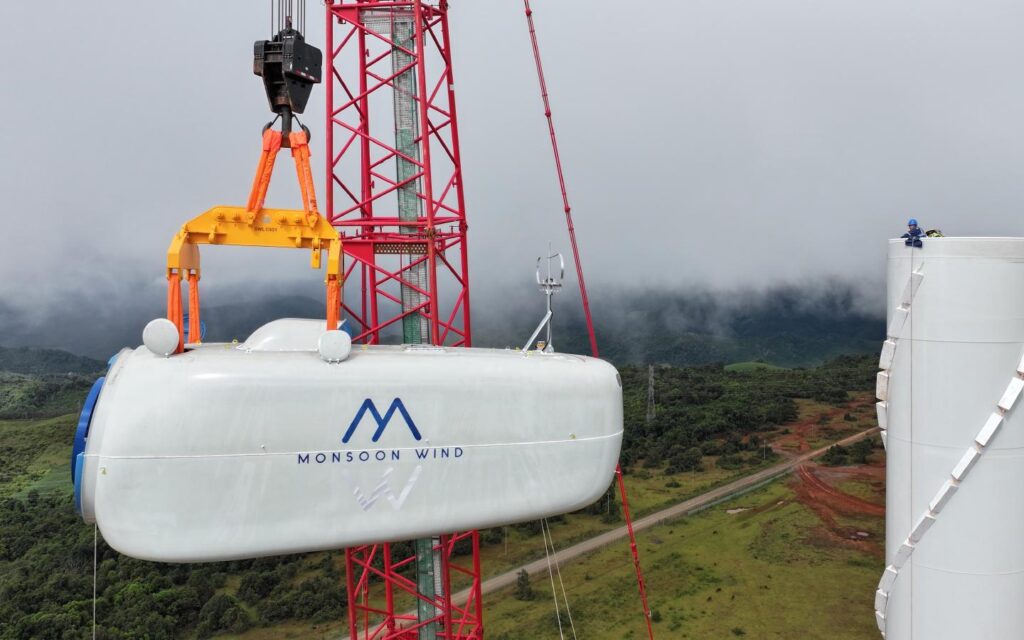Monsoon Wind Powers Up 600 MW, First Cross-Border Wind Farm in Asia

- 600 MW onshore project is the largest wind farm in Southeast Asia and the first in Lao PDR.
- Clean electricity now flows into Vietnam’s national grid, enough to power over one million homes.
- Backed by $1.1 billion in financing, the project advances ASEAN’s regional energy integration and is expected to offset 1.3 million tonnes of CO₂ annually.
A Cross-Border First for Asia’s Energy Transition
From ridgelines in southern Lao PDR, 133 turbines now send clean electricity across the border into Vietnam. The Monsoon Wind Power Project, which reached commercial operation on 22 August 2025, is the first wind farm in Laos and the first renewable energy project in Asia to transmit power internationally. At 600 MW, it is also the largest onshore wind installation in Southeast Asia.
Completed four months ahead of schedule after 27 months of construction, the project is being framed as a breakthrough for both national energy planning and regional cooperation. It diversifies Laos’ energy mix beyond hydropower and provides Vietnam with a stable inflow of clean electricity at a time of surging demand.
Infrastructure for Regional Integration
The development stretches across the Dak Cheung and Sanxay districts in Laos’ southern provinces. Power generated at the site flows through four substations, is stepped up to 500 kV, and carried along a 27-kilometre transmission line to the Lao–Vietnam border. From there, it connects into Vietnam’s 500 kV system and continues to EVN’s Thanh My substation, feeding directly into the national grid.
By proving that cross-border renewable energy projects can be technically and commercially viable, Monsoon Wind bolsters ambitions for the ASEAN Power Grid, a long-discussed vision of shared regional energy security.
Consortium Backing and Financing Structure
The project is developed and operated by Monsoon Wind Power Company Limited, a Lao-incorporated firm backed by a multinational consortium. Founding developer Impact Electrons Siam was joined by ACEN from the Philippines, BCPG and STP&I from Thailand, Mitsubishi Corporation and its subsidiary Diamond Generating Asia, and Lao-based SMP Consultation.
Financing was secured from a coalition of regional and global lenders including the Asian Development Bank (lead arranger), Asian Infrastructure Investment Bank, Japan International Cooperation Agency, Export–Import Bank of Thailand, Hong Kong Mortgage Corporation, Sumitomo Mitsui Banking Corporation, Kasikornbank, and Siam Commercial Bank. PowerChina handled construction, while Envision Energy supplied the turbines.
This broad alignment of private developers and public lenders reflects rising confidence in cross-border clean energy infrastructure and its role in delivering stable returns alongside climate benefits.
RELATED ARTICLE: Nippon Steel to Supply Wind Tower Steel to Vestas Across Europe and Asia
Voices from the Project
“This is a proud and historic moment for our company, our partners, and the region,” said Nat Hutanuwatr, Managing Director of Monsoon Wind Power. He emphasized the project’s decade-long trajectory from feasibility studies to full-scale delivery and credited governments, financiers, and communities for sustaining the effort.
Chairwoman Paradai Suebma noted that the project was “14 years in the making,” describing it as both a model of long-term vision and a practical demonstration of ASEAN nations collaborating on climate-aligned growth.Community Development and ESG Standards
Construction was completed without resettlement, in line with international environmental and social safeguard standards. The developers have committed $1.1 million annually for community development, including scholarships, mobile health services, and coffee-based livelihood programs.
By integrating local development with regional power generation, the project aims to show that utility-scale infrastructure can deliver both energy security and tangible social benefits.Implications for Investors and Policymakers
For investors, Monsoon Wind’s ahead-of-schedule completion and stable long-term offtake into Vietnam strengthen the case for cross-border renewables as bankable assets. For policymakers, it illustrates how infrastructure can deliver dual benefits: advancing domestic energy diversification while reinforcing regional integration.
The project’s expected avoidance of 1.3 million tonnes of CO₂ annually contributes directly to climate commitments under the Paris Agreement and provides a replicable template for future ASEAN initiatives.Regional and Global Significance
The Monsoon Wind project reshapes expectations for Southeast Asia’s power sector. By moving beyond single-country, single-technology reliance, it expands the options for balancing grids, attracting investment, and accelerating decarbonization.
For global ESG and climate finance leaders, it signals that the convergence of governance support, blended finance, and multinational partnerships can unlock frontier renewable projects at scale. What began as a speculative concept in 2011 now stands as evidence of how shared infrastructure can anchor the energy transition in Asia’s fast-growing economies.
Follow ESG News on LinkedIn












